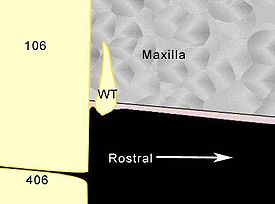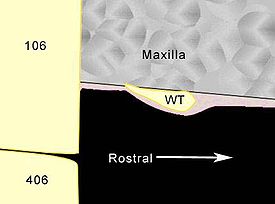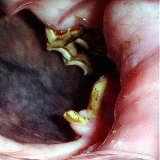
Wolf tooth
Encyclopedia
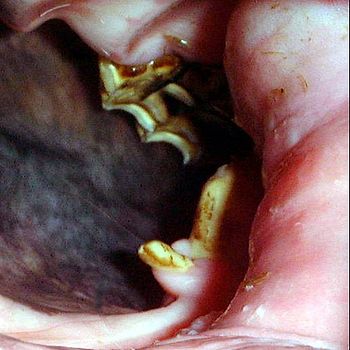
Horse
The horse is one of two extant subspecies of Equus ferus, or the wild horse. It is a single-hooved mammal belonging to the taxonomic family Equidae. The horse has evolved over the past 45 to 55 million years from a small multi-toed creature into the large, single-toed animal of today...
s and other equids. They are vestigial first premolar
Premolar
The premolar teeth or bicuspids are transitional teeth located between the canine and molar teeth. In humans, there are two premolars per quadrant, making eight premolars total in the mouth. They have at least two cusps. Premolars can be considered as a 'transitional tooth' during chewing, or...
s and the first cheek tooth is referred to as the second premolar even when wolf teeth are not present. Torbjörn Lundström in Sweden reported that about 45-50% of 25000 horses had wolf teeth. They are much less common in the mandible
Mandible
The mandible pronunciation or inferior maxillary bone forms the lower jaw and holds the lower teeth in place...
(lower jaw) than the maxilla
Maxilla
The maxilla is a fusion of two bones along the palatal fissure that form the upper jaw. This is similar to the mandible , which is also a fusion of two halves at the mental symphysis. Sometimes The maxilla (plural: maxillae) is a fusion of two bones along the palatal fissure that form the upper...
(upper jaw) although mandibular wolf teeth are found very occasionally.
They do not have any deciduous
Deciduous
Deciduous means "falling off at maturity" or "tending to fall off", and is typically used in reference to trees or shrubs that lose their leaves seasonally, and to the shedding of other plant structures such as petals after flowering or fruit when ripe...
precursors but they may themselves be deciduous as it is believed that they are often shed when the deciduous 2nd premolar is shed at around two and a half years of age. They may also be knocked out by the bit if particularly loose and can certainly be extracted accidentally, either partially or whole, when routine equine dentistry
Horse teeth
Horses' teeth are often used to estimate the animal's age, hence the sayings "long in the tooth", "straight from the horse's mouth" and "Don't look a gift horse in the mouth".- Types of teeth :At five years of age a horse has between 36 and 44 teeth...
is performed.
In size they are extremely variable from being small pegs only 3 mm in diameter to having roots up to 2 cm long. In a small number of cases they may be "molarized" with a distinct irregular rim of enamel. It is impossible to gauge the size of the root from an examination of the crown except to say that if the crown is mobile it is very unlikely that there is a large intact root.
There is dispute as to the average time of eruption with different authors suggesting different times. All authors who have performed any type of rigorous study suggest that they erupt between birth and 18 months although most say 6–9 months.
Where there are two wolf teeth next to each other it is very likely that one is a fragment of the deciduous 2nd premolar.
Blind wolf teeth
Blind wolf teeth are wolf teeth that are present but may not have erupted through the gum. They may remain completely underneath the gingiva. A good rule that holds true in most cases is:- The further forward or rostral a wolf tooth is, the more likely it is that the wolf tooth will be blind and the more likely that the root will lie more parallel with the maxilla rather than perpendicular to the line of the maxilla.
This is shown in the diagrams below where 106 and 406 are the second premolars according to the Modified triadan system
Modified triadan system
The Modified Triadan System is a scheme of dental nomenculature that can be used widely across different animal species. It has now gained wide acceptance and is used worldwide among veterinary surgeons.Each tooth is given a three digit number....
and WT is the wolf tooth. The pink layer is the gum.
How wolf teeth might cause problems
Normal wolf teeth without pathologyPathology
Pathology is the precise study and diagnosis of disease. The word pathology is from Ancient Greek , pathos, "feeling, suffering"; and , -logia, "the study of". Pathologization, to pathologize, refers to the process of defining a condition or behavior as pathological, e.g. pathological gambling....
are not inherently painful to a horse which does not have a bit
Horse tack
Tack is a term used to describe any of the various equipment and accessories worn by horses in the course of their use as domesticated animals. Saddles, stirrups, bridles, halters, reins, bits, harnesses, martingales, and breastplates are all forms of horse tack...
in its mouth. Equally certain is that there are cases where wolf teeth do cause significant problems to horses because of their interaction with the bit.
There are four mechanisms which have been postulated by which wolf teeth may cause discomfort. It is probable that all four of these mechanisms are possible in different cases.
- The wolf tooth and/or periodontiumPeriodontiumPeriodontium refers to the specialized tissues that both surround and support the teeth, maintaining them in the maxillary and mandibular bones. The word comes from the Greek terms peri-, meaning "around" and -odons, meaning "tooth." Literally taken, it means that which is "around the tooth"...
is inherently painful- Only likely where the tooth is pathological or very loose
- Unlikely to be true for healthy wolf teeth
- The bit pushes the cheek towards a sharp/large wolf tooth causing cheek pain
- Certainly a viable mechanism where the wolf tooth is large and positioned so that it has close contact with the buccal mucosa
- The bit touching a wolf tooth causes pain or discomfort in wolf tooth
- Possible if bit is being pushed towards tooth with force or tooth is inherently sensitive to pressure or contact with bit
- A wolf tooth physically restricts the movement of the bit
- Only with very large or rostrally positioned wolf teeth
Assessing which wolf teeth should be removed
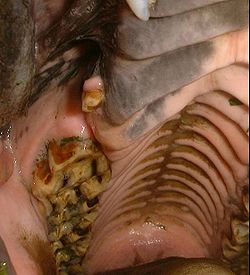
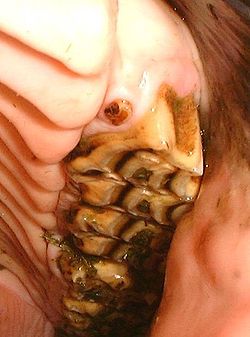

The following factors are useful in making an assessment:
- Position
- A wolf tooth that is positioned rostrally is more likely to have direct contact with the bit or to pinch buccal mucosa pushed towards it by the bit. A wolf tooth tucked in on the inside of the 2nd premolar is much less likely to be a cause of problems.
- Size
- A large wolf tooth is more likely to interfere although a small one may be such a small job to take out that it is better to just remove it.
- Movement
- Any wolf tooth which moves is likely to be small, a fragment or be a fractured crown. All three are probably better removed.
- Damage
- Any damaged wolf tooth is more likely to be inherently painful or have periodontal disease associated with it.
- Asymmetry
- Common sense suggests that where a horse only has one wolf tooth it is less likely to have a uniform response to the bit on both reins.
- Whether they are blind
- Many veterinarians and equine dental technicians believe that blind wolf teeth are more likely to be problematic.
- Whether they are maxillary or mandibular
- It is without dispute that mandibular wolf teeth are more likely to cause interference than maxillary wolf teeth because the bit is drawn towards the mandible with most bit/bridleBridleA bridle is a piece of equipment used to direct a horse. As defined in the Oxford English Dictionary, the "bridle" includes both the headstall that holds a bit that goes in the mouth of a horse, and the reins that are attached to the bit....
arrangements. - The intended use of the horse
- Where a horse is performing at a high level it is less acceptable to have any doubt in relation to possible problems caused by wolf teeth.
- The age of the horse
- Where wolf teeth are discovered in an elderly horse there are strong arguments for maintaining a status quo.
- How the horse is performing
- Most authorities would agree that any horse with wolf teeth that is not responding well to the bit should have them removed.


